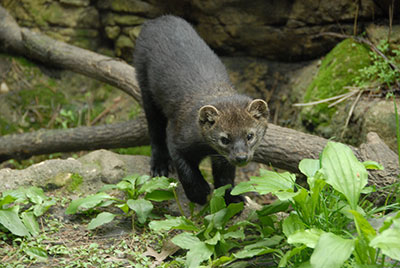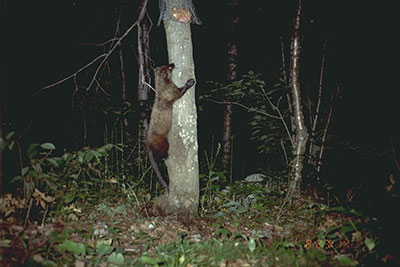Fisher
(Martes pennanti)
Description & Range:
Fishers are a dark brown-black color. They have a long body characteristic of the weasel family in addition to a bushy tail and short legs. Fishers are large members of the weasel family. The males are typically between 36 to 40 inches while females are 30 to 36 inches. Male fishers can weigh up to 12 pounds while females can get up to 8 pounds.
Fishers were almost extirpated (locally extinct) from Maryland in the 1850s due to loss of much of its forested habitat. Fishers have made a tremendous comeback in Maryland and now occupy much of western Maryland. Fishers are common in the Northeast and Midwest but are rare in the Northern Rockies and Northwest.

Fisher by Josh More, Flickr CC BY-NC-ND 2.0
Habitat:
Fishers live in large tracts of coniferous or mixed hardwood-softwood forests containing large trees for denning. Fishers prefer habitat with dense over stories for cover and hunting.

Fisher in snow by Troy Lilly Flickr CC BY-SA 2.0 http://www.forestwander.com/
Diet:
Fishers feed on a variety of small mammals such as squirrels, rabbits, mice and voles. In addition to small mammals, fishers are one of the few animals that eat porcupines. Fishers will flip porcupines over to eat them. Fishers also eat carrion, fruits, mast (primarily beechnuts), birds, and frogs.
Reproduction:
Fishers mate in March through April, but gestation will take 51 weeks. Female fishers will den in hollow trees and will give birth to 2-4 young in late February through March. The young will stay with their mother until fall.
Behavior:
Fishers are solitary, nocturnal animals. Fishers don’t stalk their prey, rather they rely on surprising prey. Fishers hunt by zig-zagging through areas of thick, regenerating forest. They also traverse areas with little ground cover in a relatively straight line, hardly changing direction. Fishers can climb trees and will often den in tree cavities or in dense conifers.
Management:
Annual hunting and trapping seasons for fishers have been established in Maryland. Fishers are managed as fur-bearing animals. To learn more about furbearer management, please click here.
Despite their name, fishers rarely eat fish! It is believed the name fisher came from the English word “fitch” which meant polecat. English settlers may have mistaken fishers for polecats. When a fisher is upset, it will produce loud growls and hissing coughs!

Fisher climbing tree, Wikimedia, public domain